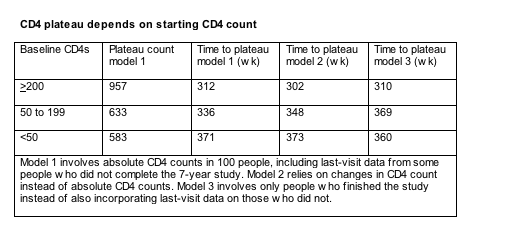 |
 |
 |
| |
CD4s Plateau at Lower Level When Treatment Starts Late
|
| |
| |
46th ICAAC, September 27-30, 2006, San Francisco
Mark Mascolini
September 29, 2006
A 7-year study of treatment-naive people starting lopinavir/ritonavir found that CD4 gains flattened out in the normal range when people began treatment with CD4 counts above 200. But people who started therapy with lower counts saw their CD4 gains flatten out at 500 to 600.
Abbott researchers analyzed CD4 trends in 100 people who began lopinavir/ritonavir plus d4T and 3TC as their first regimen in a clinical trial. Seventeen had a pretreatment count under 50, 19 started therapy with 50 to 199 CD4s, and 64 started with 200 CD4s or more. After 7 years of follow-up CD4 gains averaged 532 in the sub-50 starting group, 476 in the 50-to-199 group, and 495 in the 200-or-more group.
Although people who began their lopinavir regimen at lower counts continued to gain CD4 cells longer than people who began with 200 or more CD4s, their counts never caught up to those of the early starters. Counts plateaued around 500 to 600 in the sub-200 starting group and around 900 in the 200-plus starting group.
The Abbott team used a mathematical model incorporating data from this study group to describe CD4 climbs. According to this model, people who began their triple regimen with fewer than 50 CD4s reached a plateau at treatment week 371 with 588 CD4s, people who began with 50 to 199 CD4s hit their plateau at treatment week 336 with 633 CD4s, and people who began with 200 or more T cells reached their plateau at week 312 with 957 cells (Table). Analyses based on CD4 change from baseline and CD4 changes only in people who completed the 7-year study found similar plateau times.

These findings come close to results of a Dutch ATHENA Cohort analysis [2]. Among people treated for more than 5 years in ATHENA, those who began a potent regimen with fewer than 50 CD4s gained an average 499 cells, those who started with 50 to 199 CD4s gained an average 429, and those who started with 200 or more CD4s gained an average 412.
But whether the modeling predictions of the Abbott study hold true for regimens not hinged on lopinavir remains unclear. Earlier research found that people taking a lopinavir regimen gained more CD4s every year than those taking another ritonavir-boosted PI [3]. And recently reported results of AIDS Clinical Trials Group study A5142 found significantly higher 96-week CD4 counts in previously untreated people randomized to lopinavir/ritonavir plus two nucleosides than in people starting efavirenz and two nucleosides [4].
The Abbott researchers did not speculate on why CD4 gains peter out at a lower level among people who start antiretrovirals with fewer T cells.
References
1. King M, Da Silva BA, McMillan F, et al. When does the CD4+ cell count plateau? Evidence from subjects treated with a lopinavir/ritonavir-based regimen for up to 7 years. 46th ICAAC. September 27-30, 2006, San Francisco. Abstract H-1383.
2. Gras L, Van Sighem A, Frase C, et al. Predictors for changes in CD4 cell count 7 years after starting HAART. 13th Conference on Retroviruses and Opportunistic Infections. February 5-8, 2006. Denver. Abstract 530.
3. Mocroft A, Phillips A, Ledergerber B, et al. Relationship between antiretrovirals used as part of a cART regimen and CD4 cell count increases in patients with suppressed viremia. AIDS 2006;20:1141-1150.
4. Riddler SA, Haubrich R, DiRienzo G, et al. A prospective, randomized, phase III trial of NRTI-, PI-, and NNRTI-sparing regimens for initial treatment of HIV infection--ACTG 5142. XVI International AIDS Conference. August 13-18, 2006. Toronto. Abstract THLB0204.
|
| |
|
 |
 |
|
|